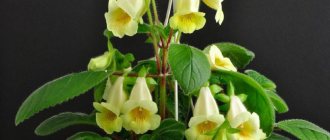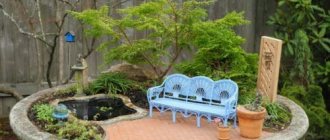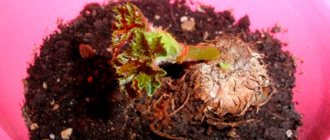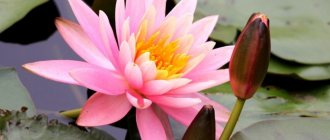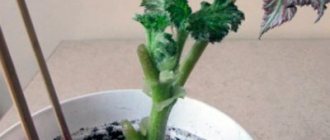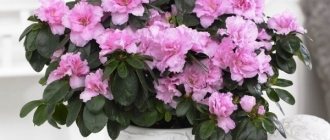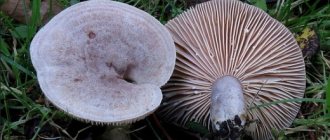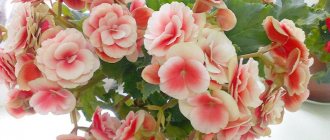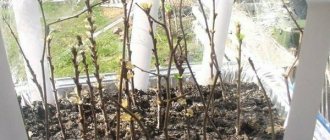Begonia - reproduction
Flower growers divide begonias into two groups - tuberous and root. There are several ways to propagate this indoor flower:
- Seeds.
- Stem cuttings.
- Vegetatively.
- Tubers.
- Leaf.
Now it’s worth dwelling in more detail on each of them in order to know how begonia should reproduce correctly. It is worth noting that for each type of begonia you need to select your own method of reproduction.
When using any method of begonia propagation, you need to know that spring is the most favorable period for this procedure. Considering that such a beauty is not cheap in stores, it can be easily propagated in a convenient way at home.
Division by tubers
This method is the most common among gardeners. The tuber is divided into several parts so that each individual one has a bud. The cut areas must be sprinkled with ash.
For planting, only moist soil is used, into which the tuber is lowered vertically. Next, the dishes with the tuber are covered with film and placed in a well-lit place indoors.
After a while, the tuber will take root and take root, after which the film is removed, and the begonia is transplanted into a specially selected pot for growing the flower.
Propagation by leaf cuttings
This method is ideal for those who want to get as much planting material as possible
This method of propagating begonias will require careful handling. Before you start, you need to cut off the healthiest and strongest leaf.
It is placed on the glass and the edges are trimmed without affecting the thick veins. The remaining sheet is divided into squares and dipped into a mixture of sand and peat or sand. After 15–20 days they should take root.
The container with seedlings must be covered and cannot be touched during this time. As soon as the shoots appear, the shelter can be removed; young shoots need ventilation. Then the shelter is put back in place. This method of propagating begonias is excellent for a flower with a creeping stem.
Stem cuttings. This method is suitable for bush begonias. Take a cutting with two buds and make two cuts on it. One cut should be at the top and the other at the bottom.
It is also necessary to remove half the large leaves on the cuttings. They must be covered with transparent dishes or polyethylene. The cover is periodically removed so that the cuttings can ventilate.
Further care of seedlings
Once it has become clear how begonia reproduces, it is worth understanding how to properly care for it. After transplanting the seedlings into separate pots, caring for them becomes easier. This plant is light-loving, so it is worth placing it in a well-lit room, while protecting it from direct sunlight. It is recommended to choose windows facing east or southwest. The temperature in the room where the flower is located should not fall below 20 °C.
Spectacular begonia
The substrate should not be constantly wet, so you should not be too zealous about watering the flower. Also, you should not spray the sprouts, since it is enough to only humidify the air. For these purposes, you need to place a reservoir of water next to the flower.
Important! Fertilizing should be applied a couple of times a month from spring to autumn. To do this, it is worth using complex mineral fertilizers. From time to time it is worth checking begonia for diseases and pests, since young plants are more susceptible to them.
With proper care, you can easily grow young begonias that will delight you with bright blooms. To do this, you just need to choose the appropriate method of propagation and follow all the instructions.
Features of growing begonia flowers
In our climatic conditions, begonia in open ground can only grow in warm weather. It is mainly grown at home on windowsills, since many varieties are heat-loving plants.
Many lovers of begonia also grow it in open flower beds and alpine hills. With the onset of cold weather, it is again placed in houses.
The total number of begonia species is about 1,000, including annuals and perennials. The plant belongs to the genus Begoniaceae, which, according to the shape of the aerial part, can be:
- herbaceous plants;
- semi-shrub;
- low-growing shrubs.
Begonia everblooming is attractive not only for its bush shape. Its variety of bright colors of inflorescences and leaf shapes can amaze any gardener. The sizes of begonias are also surprisingly varied.
The smallest ones can grow up to several centimeters. There are varieties of begonias that reach a height of 3 meters.
Begonia can be decorative-flowering or decorative-deciduous. Due to its popularity, breeders began to develop new hybrid species based on tuberous begonia. After this, large-flowered species began to appear.
Description of the plant
Begonia is a real treasure for the gardener . Among its species you can find both beautifully flowering and deciduous ornamental plants. The diversity is so wide that it is quite difficult to describe begonia as a separate plant.
Drop-shaped, round, elongated, maple leaf or heart-shaped leaves of deciduous begonia are stunning in their shape. In addition, they have a very diverse color: red, black-red, silver, speckled, with complex patterns, pink-green, purple and gray leaves.
Beautifully flowering species of begonias amaze with no less diversity . During the flowering period, the bushes are densely strewn with simple and rose-shaped complex flowers. Yellow, white, cream, orange, red, pink and purple petal shades can be found among the variety of varieties of this plant.
Choosing a vessel for rooting
The plant has small roots, so you should choose a low, small pot for it. In this case, the substrate will quickly get rid of excess moisture, so it is less likely to die. In this case, during rooting, the plant will not remain in the container for long; when roots appear, you will need to choose an individual pot.
Note! Lighting for cuttings is necessary to the same extent as for adult plants, so the rooting period should be carried out in a well-lit place. You can use a regular plastic cup as a vessel.
The pot that will be used after transplantation should not be more than 800 ml in volume, and it is worth making a hole in the bottom so that excess water can drain through it. If the plant becomes cramped in the pot, you will have to choose a larger option. After replanting, it is recommended to keep the plant for a couple of days in a darker place than usual.
Air layering
The air layering method is recommended for plants with long shoots. To get a daughter begonia, you should choose a branch whose length exceeds 20 cm. About 10 cm on this stem should be cleared of leaves, and a ring cut of up to 2 mm should be made on it. The cut itself must be treated with a root formation activator and wrapped in moistened sphagnum moss. This place needs to be wrapped in dark polyethylene, securing its edges.
Air layering method
Note! You need to completely wrap the moss in plastic to prevent it from drying out. Otherwise, root formation will not occur.
In about two months, roots will appear. It is necessary to cut off the shoots and plant them in special soil for begonias. This method should be used if the plant has come out of the dormant period and has begun to actively develop.
Additional recommendations
It is better to plant rooted begonia cuttings in a wide but shallow pot. The roots of the flower are on the surface. Be sure to place a layer of drainage (pieces of red brick or large expanded clay) on the bottom of the container.
A young sprout of tuberous begonia should be planted so that the tubers are at a distance of 2 cm from the edge of the pot.
The growing point of the cutting (or root collar) should be at the level of the soil surface. There is no need to deepen it.
Immediately after transplanting, you need to place the pot in a shaded place. You can move it to a lighted area of the house after 3 days.
How to plant a tuberous species?
For propagation, healthy begonia tubers 2-3 years old are selected, where there are already buds or they are actively appearing. If shoots have already started, it is not recommended to divide it.
Procedure:
- Prepare wide planting containers with spilled soil.
- The tuber is cut with a sharpened knife into 2-4 parts, so that each has 1-2 buds.
- The cut is dusted with ash or crushed activated carbon for disinfection.
- Each fragment is planted in the ground, buried halfway.
- Cover with a transparent lid or film.
- Leave in a moderately warm place, protected from direct sunlight.
- When the sprouts reach a height of 7-10 cm, they are transplanted into small pots.
From the video you will learn about the propagation of begonia by dividing tubers:
Dividing the bush
The overgrown begonia can be divided into 2-3 plants.
Sequence of work, how to plant:
- adult begonia is well watered;
- carefully remove from the pot, remove old leaves and thick stems, wash the roots;
- using a knife, divide into parts so that each contains sprouts and roots;
- transplanted into pots of smaller diameter than the old one.
Preparation of planting material
How to properly plant a begonia cutting? Initially, it is necessary to select good planting material. Cuttings can be taken from the top of the bush or from side shoots. Usually it is possible to collect a lot of planting material when pruning a bush. Begonias are considered very tenacious, so for rooting they actually need only one growth point (leaf or bud on a branch). But it’s better if there are 3-4 of them. Therefore, cuttings are made 15-20 cm long, with an oblique cut at the bottom. The bottom leaf is cut off completely, a third is cut off from the top ones so that the leaf plates do not absorb a lot of vital juices.
For leaf cuttings, select leaves that are strong, without signs of disease, yellowing, or wilting, with developed veins.
There are two main ways to root begonia from cuttings - in water or soil. They are considered to be equivalent. But when planting in water, cuttings need to be prepared with a reserve, since some will certainly be lost. In addition, there is an opinion that when planted directly into the ground, healthier and stronger plants are obtained.

